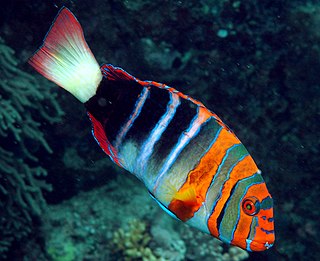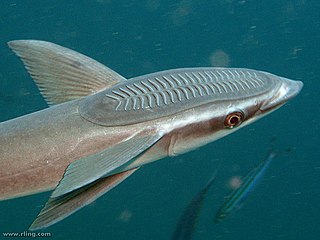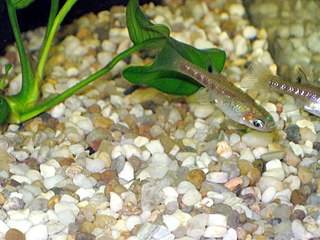
Philibert Commerson, sometimes spelled Commerçon by contemporaries, was a French naturalist, best known for accompanying Louis Antoine de Bougainville on his voyage of circumnavigation in 1766–1769.

Choerodon is a genus of wrasses native to the Indian Ocean and the western Pacific Ocean. They are commonly referred to as tuskfish, because most species have sharp tusk-like teeth.
George Sprague Myers was an American ichthyologist who spent most of his career at Stanford University. He served as the editor of Stanford Ichthyological Bulletin as well as president of the American Society of Ichthyologists and Herpetologists. Myers was also head of the Division of Fishes at the United States National Museum, and held a position as an ichthyologist for the United States Fish and Wildlife Service. He was also an advisor in fisheries and ichthyology to the Brazilian Government.

Echeneis is a genus of fish in the family Echeneidae, the remoras. The genus is distributed in the Atlantic, Pacific and Indian Oceans.

Ecsenius schroederi, known commonly as the Schroeder's combtooth-blenny in Indonesia, is a species of combtooth blenny in the genus Ecsenius. It is found in coral reefs in the western Pacific ocean, specifically in Indonesia. It can reach a maximum length of 7 centimetres. Blennies in this species feed primarily off of plants, including benthic algae and weeds, and are commercial aquarium fish. The species was named in honour of the wildlife artist and scientific illustrator Jack R. Schroeder (1954-2004).

Enneapterygius tutuilae, known commonly as the high-hat triplefin or rosy cheek threefin, is a species of triplefin blenny in the genus Enneapterygius. It was described by David Starr Jordan and Alvin Seale in 1906. This species occurs from the eastern Indian Ocean around the Cocos (Keeling) Islands east to French Polynesia. Its specific name refers to the Samoan island of Tutuila where the type was collected.
Enneapterygius randalli, the Rapa triplefin, is a species of triplefin blenny in the genus Enneapterygius. It was described by Ronald Fricke in 1997. who honoured the American ichthyologist John Ernest Randall in its specific name, Randall collected many of the type series. This species is known only from French Polynesia where it is found off Rapa Iti and Marotiri in the southern Austral Islands.
Enneapterygius williamsi, known commonly as the William's triplefin, is a species of triplefin blenny in the genus Enneapterygius. It was described by Ronald Fricke in 1997. Its specific name honours the collector of the type, the ichthyologist Jeffrey T. Williams of the Smithsonian Institution.
The red-eye threefin is a species of triplefin blenny in the genus Helcogramma. It was described by Albert William Herre in 1944 who honoured the Scottish naturalist and ethnologist Walter Elliot (1803-1897) in its specific name. This species occurs in the Indian Ocean along the eastern and western coasts of India and around Sri Lanka.

Hudson's triplefin is a species of triplefin blenny in the genus Helcogramma. It was described by David Starr Jordan and Alvin Seale in 1906, the specific name honouring the illustrator of their monograph on Samoan fishes, R.L. Hudson. This species is found in the western Pacific Ocean where it has been recorded from the Izu Islands, Ryukyu Islands, Savo Island, New Caledonia, Vanuatu, Fiji, and Samoa.
Cunningham's triplefin is a species of triplefin blenny in the genus Helcogrammoides. It was described by Frederik Adam Smitt in 1898, who named it in honour the Scottish naturalist Robert Oliver Cunningham (1841-1918), who had collected specimens of this fish from Puerto Madryn in 1868 but was unable to identify them. This species has been found in Peru, near Lima, Chile, Puerto Madryn in Argentina and the Falkland Islands.

The scalyhead triplefin is a species of triplefin blenny in the genus Norfolkia. It was described by Allan Riverstone McCulloch and Edgar Ravenswood Waite in 1916. Under the synonym Norfolkia lairdi it was the type species of Fowler's new genus. This species has been recorded from off Queensland, Norfolk Island, Lord Howe Island, New Caledonia and the Loyalty Islands. The adults occur in tidal pools among areas of coral reef.

Alfaro is a genus of poeciliid fishes endemic to Central America. The generic name honours the Costa Rican archaeologist, geologist, ethnologist, zoologist and Director of the National Museum of Costa Rica, Anastasio Alfaro (1865-1951).
Carlhubbsia is a genus of poeciliids native to Guatemala and Mexico. The name of this genus honours the American ichthyologist Carl Leavitt Hubbs (1894-1979) who originally named the genus Allophallus, a name which was preoccupied by a genus of Diptera.

Girardinus is a genus of poeciliids native to Cuba. The name of this genus honours the French zoologist Charles Frédéric Girard (1822-1895) for his work on the freshwater fish of North America.
Aspasmodes briggsi is a species of clingfish native to the Seychelles. This species grows to a length of 2.5 centimetres (0.98 in) SL. This species is the only known member of its genus. This species was described by J.L.B. Smith in 1957 from a type collected at La Digue, Seychelles. The specific name honours the author of a 1955 monograph on the clingfishes, the American ichthyologist John "Jack" C. Briggs (1920-2018) of the University of Florida.
John Ernest "Jack" Randall was an American ichthyologist and a leading authority on coral reef fishes. Randall described over 800 species and authored 11 books and over 900 scientific papers and popular articles. He spent most of his career working in Hawaii. He died in April 2020 at the age of 95.

Selar boops, the oxeye scad, is a species of ray-finned fish in the family Carangidae, the scads, jacks and trevallies. It is found in the Indo-Pacific. It is an important species for fisheries in some parts of its range.
Helen K. Larson is an ichthyologist who specialises in the fishes of the Indo-Pacific.
Phillip Clarence Heemstra was an American-South African ichthyologist. He was born in Melrose Park, Illinois, United States as the son of Clarence William Heemstra and his wife, Lydia. He attended school in Ottawa, Illinois, and completed a B.Sc. Zoology in 1963 at the University of Illinois at Urbana, Illinois, as well as his MSc degree (1968) and doctorate (1974) in marine biology at the University of Miami in Miami, Florida. He moved to live in South Africa in 1978.











